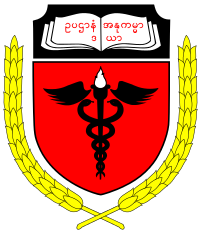Department of Paediatrics
The University of Medicine, Magway
Give us a call
11111111
Programme structure for Final Part II
Training period - 18 months
- Prebloc posting - 4 months
- Bloc posting -12 months (3 month for each group)
- Examination period - 2 months
Teaching learning methods
1. Lecture / Demonstration on history taking and clinical methods
2. Picture Quiz
3. Bedside teaching
(a) Case demonstration
(b) Supervised clinical practice
(c) Case presentation
(d) Self- practice
4. Student’s presentation (once a month) for communication and practical skills
Assessment and evaluation for Final Part II
Total marks for final exam – 100 marks ( Class work + Final exam marks )
1. Class work Final Part I ( OSCE ) 10 %
Final Part II (Theory + OSCE ) 20 %
2. Final exam (Final Part II)
Theory paper I 20 %
Theory paper II 20 %
OSCE 30 %
Pass marks 50 % each in class work, theory and OSCE
Moderation 46% in one compartment but final aggregate must be 50 %
Distinction 75% in class work, theory, all compartments of OSCE and grand viva
OSCE - 5 stations
Station 1 – History
Station 2 – Physical examination
Station 3 - Physical examination
Station 4 – Photo
Station 5 – Management
Post-graduate
Title of the Course
Master of Medical Science (Paediatrics)
Aim
The aim of the course is to provide a comprehensive training in pediatrics so as to prepare the trainee with a foundation up to a standard competent enough to become a pediatric specialist, a senior teacher in Pediatrics, or a research worker.
Objectives
The Objectives of the course are therefore to
1. Strengthen the knowledge of basic medical science and principles of Pediatrics (Knowledge)
2. Train the candidates to have competent skills in diagnosis and management of childhood disorders
(skill)
3. Stress the importance of the family and its environment in the development of childhood diseases so
that the trainees will appreciate the social and preventive aspects of Pediatrics (Attitude)
4. Impart basic research methodology so as to obtain and share more relevant information on the clinical
materials
